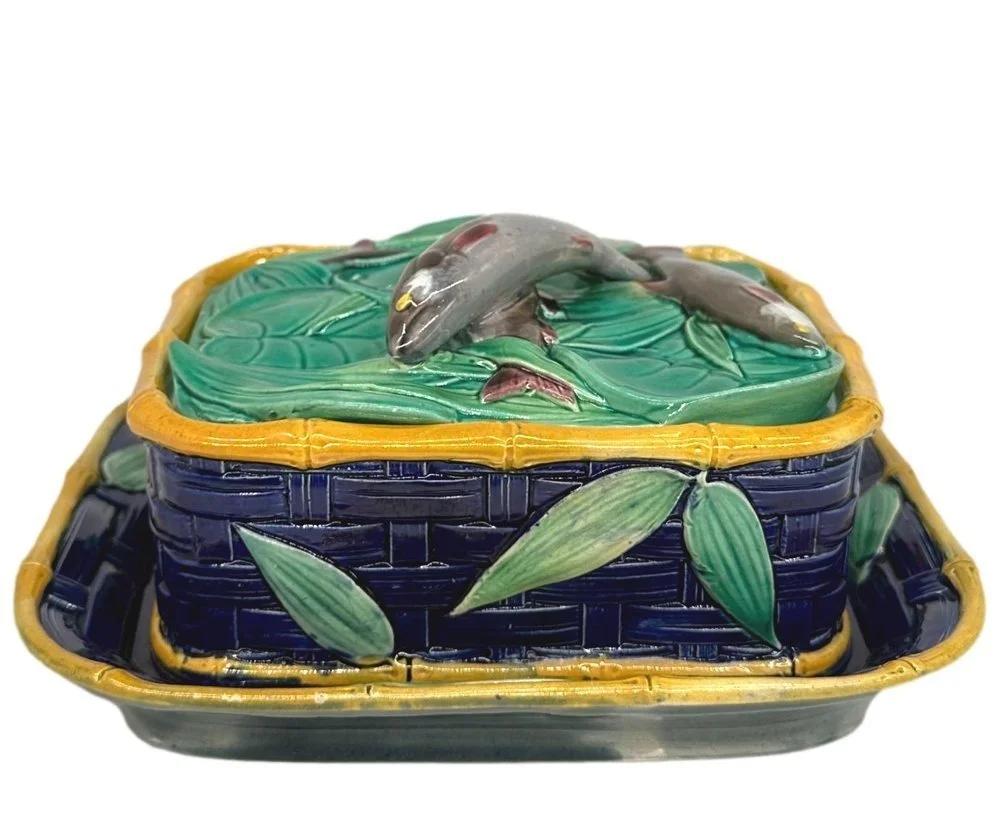 Image 1 of 18
Image 1 of 18

 Image 2 of 18
Image 2 of 18

 Image 3 of 18
Image 3 of 18

 Image 4 of 18
Image 4 of 18

 Image 5 of 18
Image 5 of 18

 Image 6 of 18
Image 6 of 18

 Image 7 of 18
Image 7 of 18

 Image 8 of 18
Image 8 of 18

 Image 9 of 18
Image 9 of 18

 Image 10 of 18
Image 10 of 18

 Image 11 of 18
Image 11 of 18

 Image 12 of 18
Image 12 of 18

 Image 13 of 18
Image 13 of 18

 Image 14 of 18
Image 14 of 18

 Image 15 of 18
Image 15 of 18

 Image 16 of 18
Image 16 of 18

 Image 17 of 18
Image 17 of 18

 Image 18 of 18
Image 18 of 18

Minton Majolica White Fantail Pigeon Tureen Yellow Wicker and Oak Tree Base
Minton Majolica pigeon tureen and cover, molded as a basket supported by entwined oak branches and three Fantail Pigeons, the cover surmounted by a nesting white Fantail Pigeon, with impressed marks to reverse: 'MINTONS', with date cypher for 1881, and pattern number '777', which corresponds to 'Game Pie Dish with Pigeon on Cover and Pigeons Around Dish' in the Minton Majolica Shape Numbers Books preserved in the Minton Archives, Stoke-on-Trent, England, and reprinted in J. Jones, p. 347.* see footnote. In excellent antique condition.
Provenance: From the Collection of Marilyn G. Karmason, author of the near-definitive work on Majolica, and certainly the most often cited. This piece is pictured twice in the first edition of her book; see details and page numbers below.
Measurements: Diameter 13 x height 12.5 inches. For over 28 years we have been among the world's preeminent specialists in fine antique Majolica.
Book references: 1--Marilyn G. Karmason with Joan B. Stacke, "Majolica, A Complete History and Illustrated Survey." New York: Harry N. Abrams Publishers, 1989, pp. 10 and 47 (illustrated twice). 2--*Joan Jones, "MINTON: The First Two Hundred Years of Design and Production." Shrewsbury, England: Swan Hill Press, 1993, Appendix E, p. 347. Minton Ornamental Shapes (i.e., pattern numbers) listed Appendix E, pp. 343-377.
Minton Majolica pigeon tureen and cover, molded as a basket supported by entwined oak branches and three Fantail Pigeons, the cover surmounted by a nesting white Fantail Pigeon, with impressed marks to reverse: 'MINTONS', with date cypher for 1881, and pattern number '777', which corresponds to 'Game Pie Dish with Pigeon on Cover and Pigeons Around Dish' in the Minton Majolica Shape Numbers Books preserved in the Minton Archives, Stoke-on-Trent, England, and reprinted in J. Jones, p. 347.* see footnote. In excellent antique condition.
Provenance: From the Collection of Marilyn G. Karmason, author of the near-definitive work on Majolica, and certainly the most often cited. This piece is pictured twice in the first edition of her book; see details and page numbers below.
Measurements: Diameter 13 x height 12.5 inches. For over 28 years we have been among the world's preeminent specialists in fine antique Majolica.
Book references: 1--Marilyn G. Karmason with Joan B. Stacke, "Majolica, A Complete History and Illustrated Survey." New York: Harry N. Abrams Publishers, 1989, pp. 10 and 47 (illustrated twice). 2--*Joan Jones, "MINTON: The First Two Hundred Years of Design and Production." Shrewsbury, England: Swan Hill Press, 1993, Appendix E, p. 347. Minton Ornamental Shapes (i.e., pattern numbers) listed Appendix E, pp. 343-377.
Minton Majolica pigeon tureen and cover, molded as a basket supported by entwined oak branches and three Fantail Pigeons, the cover surmounted by a nesting white Fantail Pigeon, with impressed marks to reverse: 'MINTONS', with date cypher for 1881, and pattern number '777', which corresponds to 'Game Pie Dish with Pigeon on Cover and Pigeons Around Dish' in the Minton Majolica Shape Numbers Books preserved in the Minton Archives, Stoke-on-Trent, England, and reprinted in J. Jones, p. 347.* see footnote. In excellent antique condition.
Provenance: From the Collection of Marilyn G. Karmason, author of the near-definitive work on Majolica, and certainly the most often cited. This piece is pictured twice in the first edition of her book; see details and page numbers below.
Measurements: Diameter 13 x height 12.5 inches. For over 28 years we have been among the world's preeminent specialists in fine antique Majolica.
Book references: 1--Marilyn G. Karmason with Joan B. Stacke, "Majolica, A Complete History and Illustrated Survey." New York: Harry N. Abrams Publishers, 1989, pp. 10 and 47 (illustrated twice). 2--*Joan Jones, "MINTON: The First Two Hundred Years of Design and Production." Shrewsbury, England: Swan Hill Press, 1993, Appendix E, p. 347. Minton Ornamental Shapes (i.e., pattern numbers) listed Appendix E, pp. 343-377.









